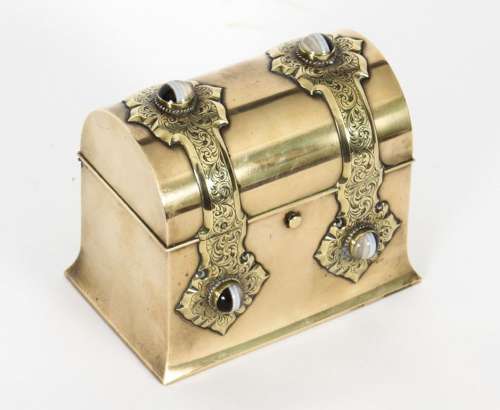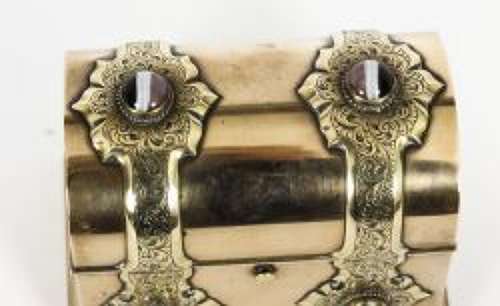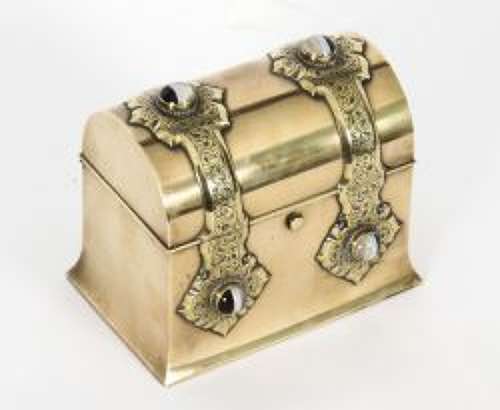Antique Ormolu & Agate Mounted Casket By Asprey C1870 19th C
Delivery Quote Request
Please fill in the form below to request a delivery quote from Regent Antiques.
Contact Regent Antiques
 London, United Kingdom
London, United Kingdom
Simply fill in the below form to get in touch with Regent Antiques regarding this item.
About this item
This is a superb antique gilt bronze and agate mounted casket by Asprey, Circa 1870 in date.
The casket features a rectangular outline with domed lid which opens to reveal two clear glass scent bottles.
It is stamped Charles Asprey, 166 Bond Street,
Provenance:
Lady Elizabeth Prinfle
Lady in waiting to Queen Victoria,
lived at Bonchurch, Isle of Wight
It is a lovely piece which will make an unforgettable gift.
Condition:
In excellent condition having been beautifully cleaned in our workshops, please see photos for confirmation.
Dimensions in cm:
Height 10.5 x Width 12.5 x Depth 7.5
Dimensions in inches:
Height 4 inches x Width 5 inches x Depth 3 inches
Asprey was established in England in 1781 and founded as a silk printing business by William Asprey, it soon became a luxury emporium. In 1841, William Asprey's elder son Charles went into partnership with a stationer located on London's Bond Street. In 1847 the family broke with this partner and moved into 167 New Bond Street, the premises Asprey occupies today.
From its central London location Asprey advertised 'articles of exclusive design and high quality, whether for personal adornment or personal accompaniment and to endow with richness and beauty the table and homes of people of refinement and discernment.' An early speciality was dressing cases. Asprey crafted traditional cases and designs, mostly in leather, suitable for the new style of travel ushered in by railways. The main competitors at the time were H.J. Cave & Sons. Asprey was recognised for its expertise when it won a gold medal for its dressing cases at the International Exhibition of 1862 but lost out to its rivals, H.J. Cave & Sons in 1867.
The company consolidated its position through acquisitions. In 1859 Asprey absorbed Edwards, an award winning maker of dressing cases and holder of a Royal Warrant. The company also purchased the Alfred Club at 22 Albemarle Street, which backed on to the New Bond Street store and meant that Asprey now had entrances on two of London's most fashionable streets.
In 1862, Asprey was granted a Royal Warrant by Queen Victoria. The Prince of Wales, later to be crowned Edward VII, granted another Royal Warrant. In 1953, for the coronation of Elizabeth II, Asprey paid homage with the Asprey Coronation Year Gold Collection, which featured a dessert, coffee and liqueur service in 18-carat gold and weighed almost 27 pounds. In April 1953, it went on show in the New Bond Street store and subsequently toured the United States.
As the business grew, the company acquired manufacturing facilities and hired silversmiths, goldsmiths, jewellers and watchmakers including Ernest Betjeman, the father of the distinguished poet John Betjeman, one of the most highly regarded craftsman and designers of his day.
In the twenties, commissions poured in from around the world, from American millionaire J. Pierpont Morgan to potentates such as the Maharaja of Patiala, who commissioned a huge teak travelling trunk for each of his wives in which each trunk was fitted with solid silver washing and bathing utensils with waterspouts of ornate tiger head and lined with blue velvet. Asprey cigarette cases became collectable amongst young sophisticates who delighted in its other modern products, including travel clocks, safety razors and automatic pencil sharpeners.
Asprey Jewellery
Asprey has a tradition of producing jewellery inspired by the blooms found in English gardens. Over the decades jewelled interpretations of flowers have evolved to include the Crown Daisy, Rose, Calla Lily and Lily Pad collections. The master diamond cutter Gabi Tolkowsky created the Asprey cut. The cushion cut gave Tolkowsky options for incorporating the Asprey "A" inscription around the edges of the stone. The result was the 61-facet Asprey cut, maximising l
Internal Ref:
A3077
Date of manufacture : 19th Century
Additional Information
960415 (AB-182424)
W: 12.5cm (4.9")H: 10.5cm (4.1")D: 7.5cm (3")
19th Century
![]() London, United Kingdom
London, United Kingdom
Regent Antiques was established in 1980. Born out of a natural love for art and beautiful objects, we have been a highly respected member of the antique fraternity ever since. Industry bodies of which we are a member include LAPADA and CINOA. Over the decades our business has gradually evolved...

























